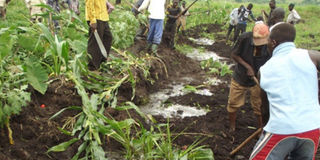Nema, police evict 300 land encroachers, destroy crops

Restoration. Nema officials assisted by residents restore depleted Musamya wetland in Kayunga District on December 15. PHOTO BY FRED MUZAALE
What you need to know:
Warning. Nema says the encroachers were evicted after being sensitised and given a grace period to harvest their crops.
KAYUNGA. In a bid to restore the degraded Musamya wetland, National Environment Authority (Nema) officials and environmental police have finally evicted at least 300 encroachers from the natural resource.
The encroachers had since 2004 claimed sections of the wetland, despite warnings from Nema officials in both Kayunga and Mukono districts to vacate.
According to Mr Nicholas Magara, the coordinator of wetlands in central region, the encroachers were using the wetland to grow rice, yams, bananas, vegetables and maize.
Mr Magara said the most depleted sections of the wetland are in Nazigo, Ntunda, Kayunga, and Kasawo sub-counties.
“The farming activities have greatly destroyed some sections of the wetland, turning it into an open land, with a stream from the hitherto marshland,” he said.
He added that the encroachers were evicted after being sensitised and given a grace period to harvest their crops. However, he noted that some of them defied the ultimatum and continued growing more crops in the wetland, which were later cut down.
During the eviction exercise last weekend, many crops were cut down while water trenches that had been dug by encroachers to drain water from their gardens were refilled with soil.
Two encroachers were also arrested but were later released.
Kayunga District senior environment Officer, Mr Patrick Musaazi, said in the past they tried to evict the encroachers but were frustrated by local politicians who spoke ill of the exercise.
According to Mr Musaazi, the encroachers come from as far as eastern Uganda, to grow rice in the wetland.
Available records indicate that the wetland, which measures about 80 miles, had shrubs, reeds; woodland and natural grasslands, but the growing demand for agriculture and sand mining has left it depleted.
2016 protest
In 2016, Kayunga District leaders went up in arms, protesting the proposed giveaway of the wetland by the Uganda Land Commission (ULC) to an investor for sugarcane growing.
The ULC chairperson, Mr Baguma Isoke, had written to Kayunga District leaders requesting to lease the wetland that covers four districts of Mukono, Kayunga, Nakasongola and Luweero to M/s Fakhri Enterprises Limited. The protests later forced ULC to back off.
Some of the encroachers said they were forced to cultivate in the wetland due to lack of arable land and asked government to allow them continue using the wetland.
However, Mr Musaazi said that they will continue monitoring the wetland and any encroacher who returns will be arrested and prosecuted in courts of law.
Wetlands are environmentally fragile areas that preserve and sieve water, but many across the country have been depleted due to human activity, increasing population and urbanisation.
Wetland degradation
Wetlands in Uganda cover less than 10 per cent of Uganda’s land surface area, however these wetland shave has been on a downward slide from 15. 6 per cent in 1994 to 10.3 per cent in 2015.
Available statistics show that Uganda has lost more than 30 per cent of the wetlands in the last 23 years. These trends indicate the country’s increased risk to effects of climate change. The President has previously ordered for the cancellation of all the titles in wetlands.




